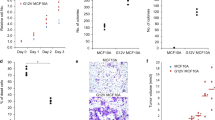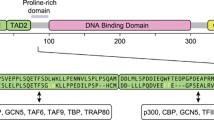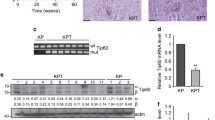Abstract
We previously identified a positive transcriptional element identical to human Ha-ras response element (HRE) within the promoter of the rat Ha-ras gene. We further identified CArG binding factor A (CBF-A), a member of heterogeneous nuclear ribonuclear protein (hnRNP) gene family, as a trans-acting factor that binds the HRE sequence with high affinity in rat mammary carcinoma cells. To determine if activation of CBF-A plays a role in tumor development in vivo, we investigated CBF-A expression and binding activity in rat mammary tumors induced by N-methyl-N-nitrosourea. We found that ~82% of tumors expressed CBF-A at levels that were 3-20 fold higher than detected in normal mammary gland. Moreover, elevated CBF-A protein levels were invariably associated with increased binding activity to the HRE. CBF-A mRNA levels in tumors were on average elevated only two fold as compared to normal mammary gland, indicating that increased CBF-A protein levels in tumors resulted from both translational and/or post-translational regulation. The level of CBF-A expression in mammary tumors was independent of Ha-ras mutational status. Together, these findings indicated that deregulation of CBF-A contributes to mammary carcinogenesis via a mechanism that is distinct from its hnRNP functions in binding and post-transcriptional regulation of RNA.
Similar content being viewed by others
References
Kamada S, Miwa T: A protein binding to CArG box motifs and to single-stranded DNA functions as a transcriptional repressor. Gene 119: 229–236, 1992
Catala F, Wanner R, Barton P, Cohen A, Wright W, Buckingham M: A skeletal muscle-specific enhancer regulated by factors binding to E and CArG boxes is present in the promoter of the mouse myosin light-chain 1A gene. Mol Cell Biol 15: 4585–4596, 1995
Madsen CS, Regan CP, Owens GK: Interaction of CArG elements and a GC-rich repressor element in transcriptional regulation of the smooth muscle myosin heavy chain gene in vascular smooth muscle cells. J Biol Chem 272: 29842–29851, 1997
Zilberman A, Dave V, Miano J, Olson EN, Periasamy M: Evolutionarily conserved promoter region containing CArG*-like elements is crucial for smooth muscle myosin heavy chain gene expression. Circ Res 82: 566–575, 1998
Mack CP, Owens GK: Regulation of smooth muscle alpha-actin expression in vivo is dependent on CArG elements within the 5’ and first intron promoter regions. Circ Res 84: 852–861, 1999
Galvagni F, Cartocci E, Oliviero S: The dystrophin promoter is negatively regulated by YY1 in undifferentiated muscle cells. J Biol Chem 273: 33708–33713, 1998
Soulez M, Tuil D, Kahn A, Gilgenkrantz H: The serum response factor (SRF) is needed for muscle-specific activation of CArG boxes. Biochem Biophys Res Commun 219: 418–422, 1996
Martin KA, Gualberto A, Kolman MF, Lowry J, Walsh K: A competitive mechanism of CArG element regulation by YY1 and SRF: implications for assessment of Phox1/ MHox transcription factor interactions at CArG elements. DNA Cell Biol 16: 653–661, 1997
Krecic AM, Swanson MS: hnRNP complexes: composition, structure, and function. Curr Opin Cell Biol 11: 363–371, 1999
Cartegni L, Maconi M, Morandi E, Cobianchi F, Riva S, Biamonti G: hnRNP A1 selectively interacts through its Gly-rich domain with different RNA-binding proteins. J Mol Biol 259: 337–348, 1996
Mikheev AM, Mikheev SA, Zhang Y, Aebersold R, Zarbl H: CArG binding factor A (CBF-A) is involved in transcriptional regulation of the Ha-ras promoter. Nucl Acid Res 28: 3762–3770, 2000
Dignam JD, Lebovitz RM, Roeder RG: Accurate transcription initiation by RNA polymerase II in a soluble extract from isolated mammalian nuclei. Nucl Acid Res 11: 1475–1489, 1983
Cartwright M, Mikheev AM, Heinrich G: Expression of neurotrophin genes in human fibroblasts: differential regulation of the brain-derived neurotrophic factor gene. Int J Develop Neurosci 12: 685–693, 1994
Bemark M, Olsson H, Heinegård D, Leanderson T: Purification and characterization of a protein binding to the SP6 kappa promoter. A potential role for CArG-box binding factor-A in kappa transcription. J Biol Chem 273: 18881–18890, 1998
Inoue A, Omori A, Ichinose S, Takahashi KP, Kinoshita Y, Mita S: S1 proteins C2 and D2 are novel hnRNPs similar to the transcriptional repressor, CArG box motif-binding factor A. Eur J Biochem 268: 3654–3663, 2001
Cha RS, Thilly WG, Zarbl H: N-nitroso-N-methylureainduced rat mammary tumors arise from cells with preexisting oncogenic Hras1 gene mutations. Proc Natl Acad Sci USA 91: 3749–3753, 1994
Finney RE, Bishop JM: Predisposition to neoplastic transformation caused by gene replacement of H-ras1. Science 260: 1524–1527, 1993
Zarbl H, Sukumar S, Arthur AV, Martin-Zanca D, Barbacid M: Direct mutagenesis of Ha-ras-1 oncogenes by N-nitroso-N-methylurea during initiation of mammary carcinogenesis in rats. Nature 315: 382–385, 1985
Tockman MS, Mulshine JL, Piantadosi S, Erozan YS, Gupta PK, Ruckdeschel JC, Taylor PR, Zhukov T, Zhou WH, Qiao YL, Yao SX: Prospective detection of preclinical lung cancer: results from two studies of heterogeneous nuclear ribonucleoprotein A2/B1 overexpression. Clin Cancer Res 3: 2237–2246, 1997
Sueoka E, Goto Y, Sueoka N, Kai Y, Kozu T, Fujiki H: Heterogeneous nuclear ribonucleoprotein B1 as a new marker of early detection for human lung cancers. Cancer Res 59: 1404–1407, 1999
Goto Y, Sueoka E, Chiba H, Fujiki H: Significance of heterogeneous nuclear ribonucleoprotein B1 as a new early detection marker for oral squamous cell carcinoma. Jap J Cancer Res 90: 1358–1363, 1999
Matsuyama S, Goto Y, Sueoka N, Ohkura Y, Tanaka Y, Nakachi K, Sueoka E: Heterogeneous nuclear ribonucleoprotein B1 expressed in esophageal squamous cell carcinomas as a new biomarker for diagnosis. Jap J Cancer Res 91: 658–663, 2000
Mandal M, Vadlamudi R, Nguyen D, Wang RA, Costa L, Bagheri_Yarmand R, Mendelsohn J, Kumar R: Growth factors regulate heterogeneous nuclear ribonucleoprotein K expression and function. J Biol Chem 276: 9699–9704, 2001
Zhou J, Allred DC, Avis I, Martinez A, Vos MD, Smith L, Treston AM, Mulshine JL: Differential expression of the early lung cancer detection marker, heterogeneous nuclear ribonucleoprotein-A2/B1 (hnRNP-A2/B1) in normal breast and neoplastic breast cancer. Breast Cancer Res Treat 66: 217–224, 2001
Yan-Sanders Y, Hammons GJ, Lyn-Cook BD: Increased expression of heterogeneous nuclear ribonucleoprotein A2/ B1 (hnRNP) in pancreatic tissue from smokers and pancreatic tumor cells. Cancer Lett 183: 215–220, 2002
Robinson L, Panayiotakis A, Papas TS, Kola I, Seth A: ETS target genes: identification of egr1 as a target by RNA differential display and whole genome PCR techniques. Proc Natl Acad Sci USA 94: 7170–7175, 1997
Gouble A, Grazide S, Meggetto F, Mercier P, Delsol G, Morello D: A new player in oncogenesis: AUF1/hnRNPD overexpression leads to tumorigenesis in transgenic mice. Cancer Res 62: 1489–1495, 2002
Jin Z, Houle B, Mikheev AM, Cha RS, Zarbl H: Alterations in H-ras1 promoter conformation during N-nitroso-N-methylurea-induced mammary carcinogenesis and pregnancy. Cancer Res 56: 4927–4935, 1996
Author information
Authors and Affiliations
Rights and permissions
About this article
Cite this article
Mikheev, A.M., Inoue, A., Jing, L. et al. Frequent activation of CArG binding factor-A expression and binding in N-methyl-N-nitrosourea-induced rat mammary carcinomas. Breast Cancer Res Treat 88, 95–102 (2004). https://doi.org/10.1007/s10549-004-1280-5
Issue Date:
DOI: https://doi.org/10.1007/s10549-004-1280-5




